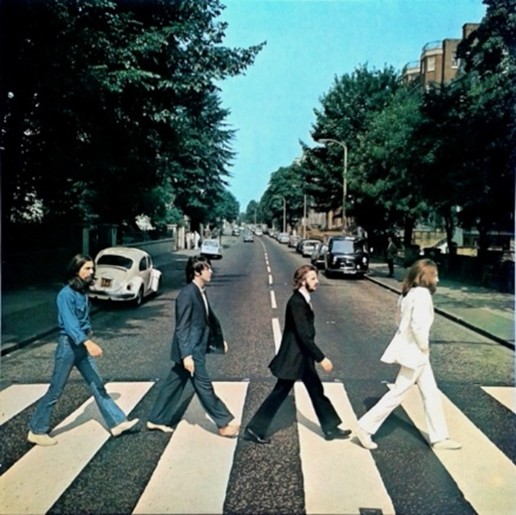
The Beatles – Abbey Road [1969]
Beware, pedestrians!
A beautiful example of a cover with no information. Yet almost every music fan knows this is the Beatles' "Abbey Road."

This iconic cover certainly belongs in any discussion of fifty years of pop history. Bands like Pink Floyd adopted this concept. Letters and logos only disrupt the graphic design, but the idea is clear. A striking image, like this one of four pedestrians on a zebra crossing, is sufficient. Or consider the black cover with a prism reflecting light. Many will immediately exclaim "Dark Side of the Moon" by Pink Floyd.
This Beatles cover has been discussed often, and yet I think I've discovered a few more "secrets."
The Beatles already knew this album would be their last. Everest was considered as a title for a while—named after the brand of cigarettes that sound engineer Geoff Emerick smoked—but the Fab Four had absolutely no desire to fly to the Himalayas just for a cover photo. Everyone was already doing their own thing.
So they opted for an easy solution: a walk outside, a quick cross-street, and then back to the studio. Paul McCartney drew a sketch that photographer Iain Macmillan could use as a guide; McCartney also chose the final photo – the only one in which the Beatles marched in step.
The studio was located on Abbey Road, in London's City of Westminster. The EMI Records building, and especially the legendary Studio 2, is inextricably linked to the Beatles, who first recorded there in 1962. In 1976, it was renamed Abbey Road Studio, likely because of the famous album. Since 2010, the building, including the zebra crossing, has been a listed building.
If you look closely, you can also see an American tourist on the cover. Paul Cole from Florida is on holiday in London with his wife. Instead of accompanying her to the museum that day, he prefers to stroll through the city by himself. He enjoys chatting with the locals. One of them is the driver of the police car on the album cover. Cole has no idea who the Beatles are; he thinks they're just long-haired scum. Later, he recognizes himself on the album cover and wants to convince at least his children of his two square centimeters of fame: "Take the magnifying glass and you'll see it's me!"
The three men dressed in white in the background above McCartney's head are upholsterers returning from their lunch break.
Well, then, The Great Conspiracy. In September 1969, a certain Tim Harper published an article titled "Is Beatle Paul McCartney Dead?", in which he suggested that the Beatle had died in late 1966 and been replaced by a doppelganger. Compared to current conspiracy theories, this seems harmless, but in the paranoid climate of America at the time, a number of persistent "evidence" flourished. For example, that the Beatles themselves had hidden clues about their bassist's death in song lyrics and on album covers. This is also the case on the cover of "Abbey Road". Left-handed Paul suddenly smokes his cigarette with his right hand and walks barefoot. Suspicious!
Life magazine quickly gave the all-clear ("Paul is still with us"), but the myth that Paul is dead continues to circulate among amateur detectives to this day.
Incidentally, there's also an Abbey Road in the London borough of West Ham, with its own station on the Docklands Light Railway. To prevent misunderstandings, an information board at the station informs Beatles fans that they've gotten off at the wrong station.
The real Abbey Road has long been a place of pilgrimage for fans and a magnet for regular tourists in London. Naturally, everyone wants to take a photo (or have one taken) while crossing the road, much to the frustration of drivers who are expected to stop at the zebra crossing. And the street sign has been stolen so often that it's now painted on the wall instead of screwed in. For those who do get off at the wrong Abbey Road, there's always the live online webcam that's on 24/7: https://www.youtube.com/watch?v=57w2gYXjRic
The Beatles hype kind of passed me by. I was too young for it back in 1969. But this long-haired scum did lay the foundation for my love of music. Bands like Yes and Genesis were inspired by the Beatles' music. And thanks to my parents and brothers, I've come to appreciate the Beatles' later music.
In a few weeks, I'm going to London. I might as well go to Abbey Road and take a picture. Those drivers will just have to wait.
Gerrit-Jan Vrielink
Translator: Alex Driessen
